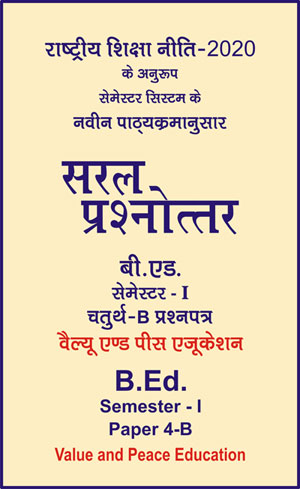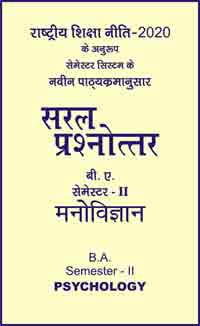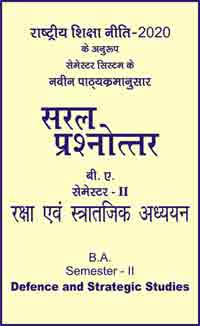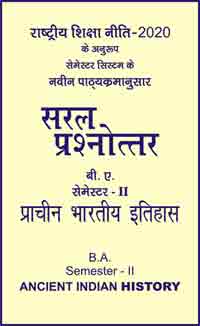|
बी एड - एम एड >> बी.एड. सेमेस्टर-1 प्रश्नपत्र-IV-B - वैल्यू एण्ड पीस एजुकेशन बी.एड. सेमेस्टर-1 प्रश्नपत्र-IV-B - वैल्यू एण्ड पीस एजुकेशनसरल प्रश्नोत्तर समूह
|
5 पाठक हैं |
||||||
बी.एड. सेमेस्टर-1 प्रश्नपत्र-IV-B - वैल्यू एण्ड पीस एजुकेशन (अंग्रेजी भाषा में)
Culture and Value
-
Which of the following is a characteristic feature of Indian society?
(a) Diversity in religious aspect and homogeneity in regional aspect
(b) Diversity in linguistic aspect and homogeneity in religious aspect
(c) Diversity in religious, regional and linguistic aspects
(d) Homogeneity in linguistic and religious aspects -
The word value is related to which language -
(a) Greek
(b) French
(c) Latin
(d) Chinese -
Which of the following challenges are due to Linguistic diversity?
(a) Demand for separate states
(b) Inter-state rivalry
(c) Communal riots
(d) Hostility towards migrants -
Which of the following can help in addressing challenges due to religious diversity through education?
(a) Educational tours to different regions
(b) Assemblies highlighting important values of different faiths
(c) Having bilingual textbooks
(d) Incentives to learn classical languages -
Which of the following can help in addressing challenges due to regional diversity through education?
(a) Organization of food festivals, celebrating other cultures.
(b) Promoting three language formula
(c) Textbooks with glossary of words of different languages
(d) Celebration of different religious festivals -
Which of the following reflects the basic philosophy of the Indian Constitution.
(a) Directive Principles
(b) Duties
(c) Fundamental Rights
(d) Preamble -
Which of the following statements is related to the constitutional value of socialism?
(a) State will not have its own religion
(b) Wealth will not be concentrated in the hands of a few
(c) There will be no external interference in the governance of the nation
(d) All citizens will have the power to vote -
Which of the following statements relates to Article 14 of the Constitution?
(a) The state shall not deny any person equality before the law
(b) All minorities shall have the right to establish educational institutions
(c) No citizen will be discriminated against in having access to public places.
(d) All citizens have the freedom to express their views and ideas -
Which of the following is the characteristic of liberalization?
(a) Lifting of unnecessary controls over the economy
(b) Greater role to the private sector in the nation-building process.
(c) Geographical boundaries not a barrier providing service to a customer
(d) Increased interactions among the various nations of the global economy. -
Which of the following is an implication on education of Liberalization, Privatization and Globalization?
(a) Downward revision of fees
(b) Upward revision of fees
(c) Increased government subsidy of education
(d) No changes in fees -
The entry of private players in education indicates which of the following?
(a) Schools offering learning programmes with economical fees
(b) Schools run with teacher centric methodologies
(c) Schools maintain their traditional structures and way of functioning.
(d) Schools run with corporate style management -
Choose the statement that aptly describes the role newspapers play in education.
(a) Newspapers provide only political information
(b) Newspapers have a limited reach among the masses
(c) Newspapers provide realistic depictions of contemporary society
(d) Newspapers are available only at certain time periods -
Which of the following commissions suggested silent meditation as a part of moral values?
(a) Indian Education Commission
(b) Secondary Education Commission
(c) National Education Commission
(d) University Education Commission -
We have spent a lot of time talking about some of the dangers to be aware of when studying culture. One of the major pitfalls of this is developing the belief that your culture is racially superior to another. What is that danger called?
(a) Segregation
(b) Racism
(c) Stereotyping
(d) Ethnocentrism -
When studying different areas of the world, it is important to have an idea of a particular region's culture before continuing. But, how do we define “culture”?
(a) A particular person's lifestyle
(b) A delicious desert from Oregon Dairy
(c) All the elements that make up a society or civilization
(d) A particular segment that has interesting values -
Anthropology is one of the main areas that helps us to analyze and interpret different cultures from around the world. But what is anthropology the study of?
(a) Creationism
(b) Government
(c) Mankind
(d) Culture -
Anthropology really started to come into its own in the 1800's due to a rise in the public's questions as to where do we (human beings) as a species come from. What British scientist developed a theory as to the evolution of man that is still very hotly debated today?
(a) Charles Darwin
(b) William Graham Sumner
(c) Robert Levy
(d) Gregory Beatson -
The cultural element of religion is probably of the most important parts of the study of culture available to researchers and also one of the most controversial. What is one of the functions of religion, within a particular culture or society?
(a) To help generate money and prestige for certain segments of society
(b) To provide reassurance and unite to a community
(c) To try and answer questions and provide morals
(d) To educate people and care for the sick and outcasts of society -
There are many motivators or reasons as to why people engage in acts of ethnocentrism. Which of the following explanations is one of the major reasons why people engage in acts of ethnocentrism that we talked about in class?
(a) People participate in ethnocentric behavior to fit into a particular group
(b) Ethnocentric behavior comes out of a lack of understanding of other cultures or a genuine fear of outsiders
(c) Young people participate in ethnocentric behavior because they see their friends participating in ethnocentric behavior and they want to be accepted.
(d) Workers participate in ethnocentric behavior because of a poor economy and the need for a scapegoat -
When talking about the Seven (7) Elements of Culture, the element of Arts and Literature emphasizes a culture's ability to express itself. Which of the following is NOT one of the examples of Arts and Literature that we talked about in class?
(a) Painting
(b) Architecture
(c) Weaving
(d) Dance -
Under National Education Policy 1972, free education was recommended upto class ?
(a) 5
(b) 12
(c) 10
(d) 18 -
Open University was established under the policy ?
(a) 1972
(b) 1985
(c) 1964
(d) 1932 -
The focus of national education policy 1978 was on ?
(a) Islamic values
(b) Ideology of Pakistan
(c) Both a and b
(d) None -
Charter Act was presented in ?
(a) 1800
(b) 1813
(c) 1800
(d) 1820 -
According to charter Act 1813, education is the responsibility of ?
(a) Governor
(b) East India company
(c) Madarus
(d) Local Govt -
The amount set apart by East India Company for educational purpose will be RS. ?
(a) 100000
(b) 15000
(c) 1400
(d) 12000 -
East India Company could not implement charter Act for ?
(a) 5 years
(b) 10 years
(c) 8 years
(d) 4 years -
Lord Macaulay/Bentick Resolution was passed in?
(a) 1852
(b) 1835
(c) 1946
(d) 1742 -
Social life consists of
(a) Music’s
(b) Participation in drams
(c) Games
(d) All of the above -
When one learns something and makes use of what he has learned is called
(a) Assimilation
(b) Co-operation
(c) Competition
(d) Conflict -
The idea that people of high and low status were all equal in the eyes of God first comes with
(a) Huns
(b) Muslims
(c) Portuguese
(d) Englishman -
Incorporating learned behaviour into own personality and makes them his ‘style of life’ is
(a) Assimilation
(b) Co-operation
(c) Competition
(d) Conflict -
The idea of equality was welcomed by the
(a) Lower caste in Hindu society
(b) Kshatriya
(c) Brahman
(d) Backwards -
Sociology should reflect the
(a) Community
(b) Customs
(c) Culture
(d) All of the above -
Caste system weakened in the 20th century’s
(a) Last fifty decades
(b) First fifty decades
(c) In the middle decades
(d) None of the above -
When a group of people learn something and change their behaviour and attitudes as a result then we can say that this group has learning
(a) Co-operated
(b) Assimilated
(c) Competited
(d) Conflicted -
Sociology is the study of society of the web tissue of human interaction and inter-relation said by
(a) Ginsberg
(b) Moore
(c) Merritt
(d) Duncan -
Social interaction includes
(a) Interaction with culture
(b) Interaction with society
(c) Interaction with family
(d) All of the above -
Participating in the removal of illiteracy is a
(a) Social change
(b) Conscience change
(c) Cultural change
(d) None of the above -
The school socialized by imparting social interaction which is/are
(a) Students vs staff
(b) Students vs student of different age
(c) Staff vs staff
(d) All of the above -
From the sociological viewpoint the functions of education are
(a) Assimilation of tradition
(b) Development of new social patterns
(c) The creative and constructive role
(d) All of the above -
The caste system showed signs of loosening up under the impact of
(a) Gandhiji
(b) Rajendra Prasad
(c) J.L. Nehru
(d) Raja Ram Mohan Roy -
Sociology Studies the effect if changes on behaviour and personality development in
(a) Society
(b) Individual
(c) Both a & b
(d) None of the above -
From the Sociological viewpoint education is regarded as a process in which there are two aspects
(a) The psychological
(b) The sociological
(c) Both a & b
(d) Biological & Sociological -
Robbins definition for sociology deals with
(a) Whole world
(b) Whole man
(c) Whole society
(d) Whole organism -
Games and Sports are
(a) Competitive
(b) Co-operative
(c) Assimilative
(d) None of the above -
In view of all sociological principals, the/ curriculum should include the subject of
(a) Social studies
(b) Physical education
(c) Health
(d) All of the above -
The group or individual have competition in
(a) Social
(b) Economic
(c) Political
(d) Competition in all areas -
During periods of prosperity and trade expansion in Indian history there appears to have been considerable -
(a) Social mobility
(b) Caste mobility
(c) Both of the above
(d) None of these -
Education should bring a change not only in the amount of knowledge gained but in
(a) To acquire habits
(b) To do
(c) Ability to think
(d) All of the above -
How many types of social processes involved in education
(a) 2
(b) 3
(c) 4
(d) 5 -
Sociological thinking in education has its impact
(a) On objective
(b) Ends in education
(c) Both a & b
(d) None the above -
In many socialist countries
(a) Co-operative housing
(b) There is co-operative farming
(c) Both a & b
(d) Either a or b -
The phrase “Social aim in education” is the one which has been upheld in the -
(a) North America
(b) United Kingdom
(c) Democratic countries
(d) All of the above -
Education should train the
(a) Individual first
(b) Society first
(c) Nation first
(d) Family first -
The common uniform dress abolishes all individual identity in the same way as the aims in
(a) Educations do
(b) Politics do
(c) Both a & b
(d) There is no relation between the subjects -
The basic scheme of education emphasises the need of a predominantly
(a) Agrarian population
(b) Rural population
(c) Both a & b
(d) All social classes -
Education for social services or education for citizenship and aims at the good of the community laying stress on teaching
(a) Science
(b) Citizenship
(c) Religious
(d) Moral values -
Social institution is/are
(a) The state
(b) The school
(c) The family
(d) All of the above -
A socially efficient individual conforms to
(a) Right way of conduct
(b) Moral standards of conduct
(c) Basic standards
(d) All of the above -
The demands of society are given priority against the inclination of the
(a) Community
(b) Individual
(c) Parents
(d) State -
Social aims in education is the one which has been upheld in the
(a) South Africa
(b) United Kingdom
(c) North America Smith Asia
(d) None of these -
Today enlightened thinking is needed, which can be promoted through the
(a) In our schools
(b) Leaderships of teachers
(c) Both S & b
(d) All of the above -
Several schools in different states are participating in the
(a) National Literacy Mission
(b) National unity
(c) National cultural change
(d) All of the above -
If education is the result of social change it means that social change has created a demand for
(a) Education
(b) Conscience
(c) Industrialisation
(d) Economic prosperity
|
|||||













